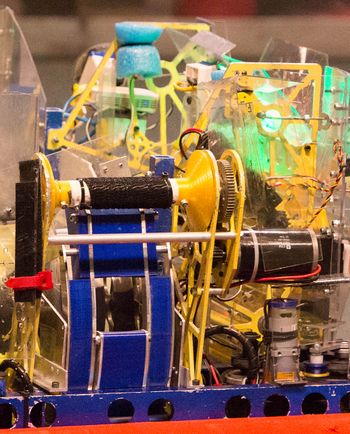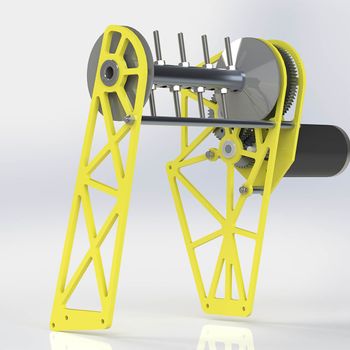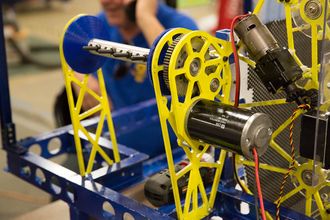DEWBOT XIII Rope Climber
Key climber requirements are:
- Reliability - The climb needs to work every time
- Speed - The climb needs to take <10 sec including engagement. Robots having faster climbs are able to continue scoring longer or delay slow-climbing robots from reaching their ropes
- Shouldn't back-drive
- Don't fall! (it hurts the robot & you lose)
Contents
Climber
A number of approaches were prototyped, before designing and developing DEWBOT's climber. The original iteration of the climber comprised an 8" long, 1" diameter aluminum tube having nine 1/4"-20 bolts set at 180 deg and staggered. The bolts engaged loops in our rope, and once engaged, the robot climbed. Printed flanges at the tube ends constrained the coiling rope and kept it from fouling the bearings.Engaging the loops with the bolts proved too unreliable and slow in practice. After Seneca, the bolt/loop system was replaced by Velcro. In making this change, we clad the aluminum tube with a 1" PVC pipe (1.315 in OD) clamshell, around which adhesive-backed hook Velcro is wrapped. The PVC pipe clamshell is replaced with the Velcro.
The climber was designed to mount on the robot superimposed over the shooter, making it space-efficient. Support plates for the climber and it's gearbox were cut from 3/16" 6061 Al using a CNC router.
Powerplant & Gearing

- A 12 tooth pinion (Vexpro 217-3099) driving a 34 tooth gear (Vexpro 217-3211), the 34T gear being coaxial with
- A 14 tooth gear (Vexpro 217-3100) driving a 54 tooth gear (Vexpro 217-3220), the 54T gear being coaxial with
- A 16 tooth gear (Vexpro 217-5450) driving a 70 tooth gear (Vexpro 217-3224), the 70T gear being coaxial with and directly driving the climber spool.
The above gearing was consistently reliable, but time from rope contact to light on is 8±1 second. Faster would be better.
At FRC Championship, the 3rd stage gears were changed to 26 tooth (Vexpro 217-5453) and 60 tooth (Vexpro 217-2714), changing the overall gear reduction from 47.8:1 to 25.2:1, thereby speeding the climb. Also consistently reliable. In-shop testing of a 28T-58T gearset (22.6:1 overall reduction) was observed to work consistently, but CIM amp measurements were too high to assure reliability in competition.
All gears are 20 DP (diametrical pitch) with 14 degree contact angle. All gears larger than 14T are 7075 Al for weight consideration. I note that Vexpro has introduced an extremely useful line of 20 DP 14 deg 7075 Al spur gears.
Ratchet
A flex-ratchet wrench was employed to prevent back-drive of the climber. 3/8" initially; later 7/16". This was mounted on the non-driven end of the climber spool. The wrench is held in place by a pin, which may be removed to facilitate lowering the robot. The wrench engaged a nut on the non-driven spool end; initially 10-32 (3/8" wrench) and later 1/4"-20 (7/16" wrench).
Rope
Our first rope concept was braided shark string (spear fishing line - mechanically stressed UHMW PE). While strong, shark string is very thin and it is likely that it would not have held up to the sharp angle on the davit very well. The braiding process was very laborious. Braided shark string was abandoned during build season.
Our rope at Westtown was standard 1/4" nylon rope with loops. This rope broke at the davit angle during two climbs. The team switched to higher strength 1/4" rope during the Westtown event following these falls.
Before FIRST Mid-Atlantic Championship, we had settled on New England Ropes Endura 12-12 Strand 1/4" polyester rope, having 4,500 lb breaking strength and very low (<1%) elongation. Techflex expandable braided sleeving covered the rope on the anchor (upper) end to protect the rope from abrasion against the davit. Velcro loop (non-adhesive back) was sewn to the rope's lower end to engage the climbing spool.
During installation, a slip knot was tied in the rope so that its end hung at the appropriate height for engaging the climber and so that a short length of rope would play out as the Velcro end wrapped around the Velcro-covered climbing spool before this Velcro bond would need to bear the robot's weight.
Sam, our robot operator, had the responsibility to set up the rope during field set-up.

